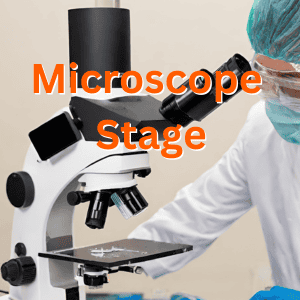Have you ever wondered how a simple glass lens revolutionized our understanding of the world? The microscope, a marvel of optics, has come a long way since its humble beginnings in the late 16th century. Today, it stands as a cornerstone in countless fields, unveiling the hidden wonders of the microscopic realm.
In this post, we’ll explore ten diverse applications that showcase how instrumental these instruments are in shaping our modern world.
Medical Diagnosis
Microscopes play a pivotal role in medical diagnosis, offering a window into the intricate details of human and pathogen anatomy that are invisible to the naked eye. This deep look allows medical professionals to detect and diagnose a wide range of diseases, often saving lives with timely intervention.
Identifying Pathogens
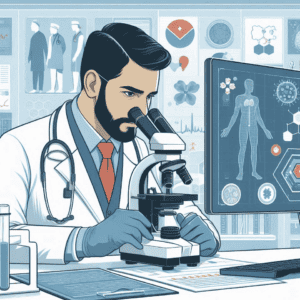 In the battle against infectious diseases, microscopes serve as critical tools. By examining samples under the lens, technicians and pathologists can identify the specific types of bacteria, viruses, or parasites causing illness. From the shape and size to the mobility patterns, each detail helps in crafting targeted treatments. For instance, tuberculosis—a disease affecting millions worldwide—requires careful microscopic examination of sputum samples to confirm the presence of Mycobacterium tuberculosis.
In the battle against infectious diseases, microscopes serve as critical tools. By examining samples under the lens, technicians and pathologists can identify the specific types of bacteria, viruses, or parasites causing illness. From the shape and size to the mobility patterns, each detail helps in crafting targeted treatments. For instance, tuberculosis—a disease affecting millions worldwide—requires careful microscopic examination of sputum samples to confirm the presence of Mycobacterium tuberculosis.
Tissue Analysis
Tissue Analysis often involves microscopes to look at the biopsy samples from organs under high magnification. This practice helps in diagnosing conditions like cancer, where the morphology of cells can indicate malignancy. Pathologists examine the size, shape, and arrangement of cells to provide diagnoses that guide treatment options.
Observing tissues at different stages of a disease can provide invaluable data about disease progression and response to treatment. Such detailed studies can lead to more personalized medicine, improving treatment outcomes. Advanced techniques like fluorescence microscopy can tag specific cellular components to watch how diseases affect different cell functions.
Ballistics
Forensic science extensively uses microscopes for examining evidence from crime scenes, including ballistic investigations. Experts compare bullets and bullet fragments, looking at the unique marks left by a firearm. This microscopic examination can link a bullet to a specific weapon and, by extension, to suspects involved in a crime.
Ballistics experts focus on the microscopic striations on bullets or cartridge casements, which are as unique as fingerprints. This precise work requires an eye for detail and an in-depth understanding of forensic science, which is often fueled by a passion for justice and truth-seeking.
In-depth knowledge of microscopic techniques, combined with a keen interest in forensic science, enables specialists to reconstruct crime scenes and provide vital evidence in legal cases, making each microscopic examination a crucial part of the investigative process.
Field |
Technique |
Application |
Nugget of Information |
|---|---|---|---|
| Medical Diagnosis | Gram Staining | Identifying bacterial infections | Vital for determining antibiotic treatment path. |
| Medical Diagnosis | Fluorescence Microscopy | Observing cellular functions in tissues | Used to study cancer cells and neurological diseases. |
| Forensic Science | Comparative Bullet Analysis | Crime scene investigations | Can link a bullet to a specific firearm used in a crime. |
| Pathology | Digital Pathology Analysis | Faster, more accurate disease diagnosis | Employs AI to enhance diagnostic precision. |
Scientific Research
Microscopes revolutionize how we understand the world at a microscopic level, particularly in scientific research. These powerful tools allow researchers to observe phenomena that are invisible to the naked eye, leading to breakthroughs in various scientific domains.
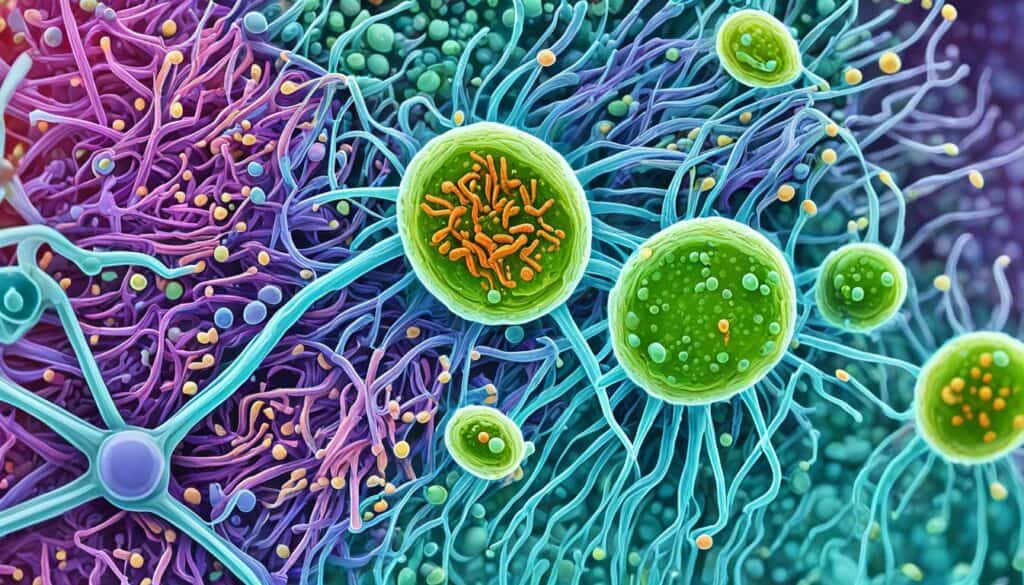
Microbiology
Microbiology relies heavily on microscopy to study microorganisms such as bacteria, viruses, fungi, and protozoa. Researchers observe the growth, behavior, and interactions of these organisms under different conditions. For example, studying bacterial biofilms under a microscope can reveal insights about antibiotic resistance and the structure of microbes, information crucial for developing new treatments.
Advanced imaging techniques like electron microscopy provide even more detail, revealing the ultrastructure of cells. Such detailed imagery helps microbiologists understand cellular processes and virus replication mechanisms at a molecular level, facilitating the development of targeted therapies and vaccines.
Genetics
Genetics is another field where microscopes are indispensable. They are used to study genetic material and its expression in cells. Techniques like fluorescence in situ hybridization (FISH) allow researchers to locate specific DNA sequences on chromosomes, helping to identify genetic anomalies and understand genetic diseases.
Moreover, live-cell imaging helps scientists observe how genes are expressed in real time. This ability to watch cellular processes as they occur has transformed our understanding of genetic regulation and mutation processes.
Environmental Science
In environmental science, microscopy helps in studying environmental impacts at a microscopic level. Microscopes analyze soil and water samples to assess pollution levels, track changes in microbial communities, and study the bioaccumulation of hazardous substances in biological organisms.
Environmental microscopes can detect the presence of microplastics in water bodies, contributing valuable data for ecological conservation efforts. Such analysis is vital in understanding how pollutants affect biodiversity and ecosystem health.
Field |
Technique |
Application |
Nugget of Information |
|---|---|---|---|
| Microbiology | Electron Microscopy | Viewing cellular ultrastructures | Crucial for understanding the inner workings of cells. |
| Genetics | Fluorescence In Situ Hybridization (FISH) | Locating and identifying genetic material | Essential for diagnosing genetic disorders. |
| Environmental Science | Water Sampling Microscopy | Assessing water quality | Used to monitor pollution and microplastic levels. |
Crime Scene Investigation
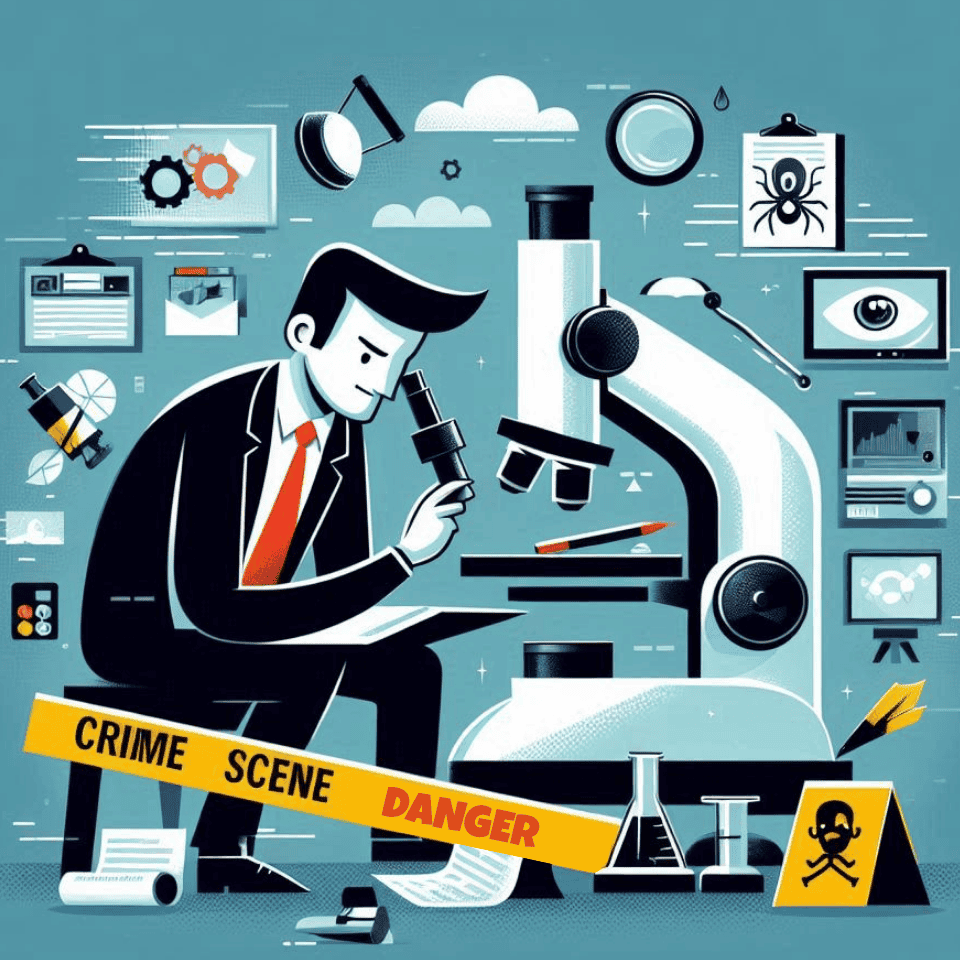
Microscopes are indispensable in the field of forensic science, providing key insights that help solve crimes by analyzing trace evidence at crime scenes. This microscopic examination goes a long to uncovering details that are crucial for building cases and achieving justice.
Forensic Analysis
Forensic analysts use microscopes to examine fibers, residues, hairs, and other materials found at crime scenes. Comparing these materials with those from suspects or their belongings can often link a suspect to the crime. Microscopic analysis of fibers can determine their origin—whether they are synthetic or natural, their color, and even their manufacturer, which can be incredibly revealing.
Additionally, pollen and spore analysis under a microscope can often pinpoint the specific location of a crime or reveal if an object or person was in a particular environment. This information is frequently used to corroborate or contradict alibi statements provided by suspects and witnesses.
For forensic enthusiasts, the application of microscopy in analyzing everyday materials opens up new methods of investigation, turning minute traces into compelling evidence.
Toolmark Analysis
In crimes involving the use of tools—whether in burglaries or assaults—microscopes allow forensic specialists to meticulously analyze marks left by these tools. Each tool leaves unique microscopic impressions on surfaces it contacts, such as wood, metal, or plastic. Experts can identify and match these impressions to specific tools, linking them to the crime scene and potentially to the suspect.
Such detailed analyses not only provide evidence linking tools to specific criminal activities but also offer a methodical approach to understanding how a crime was committed. This process involves comparing crime scene tool marks with those of tools recovered from suspects, determining patterns that could establish a connection.
Trace Evidence
The microscopy of trace evidence involves analyzing tiny materials that are transferred during the commission of a crime. This might include glass, paint, metal, or cosmetic residues. Microscopic analysis helps to identify the composition and possible origin of these materials, linking them to specific objects and locations.
For instance, glass fragments can be examined for their refractive index—an optical property that distinguishes types of glass. This can be critical in cases involving break-ins or vehicular accidents. Similarly, paint scrapings from a crime scene could be matched to a specific vehicle model, helping to track down a hit-and-run offender.
Field |
Technique |
Application |
Nugurrget of Information |
|---|---|---|---|
| Forensic Analysis | Fiber Analysis | Linking suspects to crime scenes | Fibers can pinpoint fabric type and potentially its source. |
| Toolmark Analysis | Tool Impression Microscopy | Identifying tools used in crimes | Crucial for connecting burglary tools to crime scenes. |
| Trace Evidence | Refractive Index of Glass | Determining the type of glass used | Critical in cases of break-ins and vehicular accidents. |
Environmental Science
Microscopes play a crucial role in environmental science, providing essential insights into the health and dynamics of ecosystems at a microscopic scale. These observations help scientists monitor and manage environmental health, addressing issues from pollution to conservation efforts.
Pollution Monitoring
Microscopes are essential tools for examining environmental samples, such as water, soil, and air, for pollutants and contaminants. Researchers use these tools to identify and quantify particulate matter, microplastics, metals, and other pollutants that can harm ecosystems.
For example, examining water samples under a microscope can reveal the presence of harmful algae blooms which can lead to mass fish die-offs and contaminate water supplies.
This microscopic analysis is critical for tracking pollution sources and effectiveness of regulatory measures. It also helps in developing strategies to prevent further environmental degradation, ensuring the sustainability of natural resources.
Biodiversity Studies
Studying biodiversity at the microscopic level allows scientists to explore organism interactions and ecosystems on a much finer scale. Microscopic examination of soil and water samples can reveal a rich diversity of microorganisms—bacteria, fungi, protozoa—that play vital roles in nutrient cycling and productivity.
Microscopes help track changes in these microscopic communities, which can be early indicators of environmental stress or shifts caused by climate change, pollution, or land use changes. This detailed analysis aids in conservation efforts, as maintaining a diverse microbial population is essential for ecosystem resilience.
Material Analysis
Research involving the microscopic analysis of environmental materials, such as sediment layers, plant tissues, and animal specimens, offers insights into environmental processes and historical ecological changes. For example, analyzing tree rings under a microscope can provide data about historical climate conditions, helping scientists understand past environments and predict future climate trends.
Moreover, microscopes are used to examine the structure of materials like biofilms and mineral deposits, which can indicate water quality and the presence of certain chemical elements that affect ecosystem health. This kind of detailed study helps in understanding the mechanisms of environmental impact, supporting efforts in ecological restoration and management.
Field |
Technique |
Application |
Nugget of Information |
|---|---|---|---|
| Pollution Monitoring | Water Sampling Microscopy | Identifying aquatic contaminants | Essential for tracking pollution and its sources. |
| Biodiversity Studies | Soil Analysis Microscopy | Studying soil microorganisms | Key to understanding nutrient cycles and ecosystem health. |
| Material Analysis | Tree Ring Microscopy | Analyzing historical climate patterns | Provides insights into past environmental conditions. |
Education
Microscopes serve as vital educational tools, significantly enhancing student learning in science by providing direct observation and interaction with the microscopic world. This hands-on approach fosters a deeper understanding of biological processes and scientific principles.
Classroom Learning Tools
In educational settings, microscopes transform abstract concepts into tangible experiences for students. By allowing them to observe cells, microbial life, and chemical reactions up close, these instruments make learning more engaging and impactful. For instance, when students view plant cells under a microscope, they can directly observe structures like the cell wall, nucleus, and chloroplasts, which are often only described in textbooks.
This direct visual access helps demystify complex scientific ideas, making them more accessible and easier to understand. Teachers can use microscopes not just in biology, but across various scientific disciplines to illustrate and reinforce key concepts, aiding in multidisciplinary learning.
Student Projects
Microscopes also play a crucial role in student projects and scientific research at academic institutions. They enable students to conduct detailed investigations and experiments, from analyzing environmental samples to studying cellular behavior in petri dishes. Such projects not only enhance learning but also develop critical thinking and research skills.
By engaging in microscope-based projects, students learn to formulate hypotheses, conduct systematic observations, and analyze data. These skills are essential for academic and professional success in any scientific field.
Enhancement of Science Education
By integrating microscopes into science curricula, educational institutions can significantly enhance the quality of science education. This integration helps students connect theoretical knowledge with real-world applications, making science more relevant and exciting.
Moreover, advancements in technology now allow for digital microscopes and imaging software to be used in classrooms, providing students with the ability to capture and share their observations online. This not only enhances collaborative learning but also allows for a broader discussion among peers and educators, expanding educational boundaries beyond the traditional classroom.
Aspect |
Technique |
Application |
Nugget of Information |
|---|---|---|---|
| Classroom Learning | Direct Observation | Studying cell structures | Facilitates hands-on learning and a deeper understanding of biology. |
| Student Projects | Research and Experimentation | Conducting scientific experiments | Helps develop critical thinking and practical scientific skills. |
| Science Education | Digital Imaging and Analysis | Enhancing learning engagement | Modernizes education and promotes interactive learning environments. |
Quality Control in Manufacturing

Microscopes are critical in ensuring the quality and reliability of products in the manufacturing industry. From electronics to pharmaceuticals, the use of microscopes helps maintain high standards by allowing precise examination of materials and components at a microscopic level.
Material Analysis
In manufacturing, the analysis of materials is essential for ensuring products meet required specifications and quality standards. Microscopes allow engineers and quality control specialists to examine the microscopic structure of materials to detect flaws or inconsistencies. This can include checking metal alloys for proper grain size and distribution, inspecting composite materials for uniformity, or analyzing surface treatments.
For example, in the electronics industry, microscopes are used to inspect circuit boards for soldering defects or trace damage that could lead to product failures. Such detailed inspections help prevent costly recalls and maintain consumer trust in the brand.
Precision Engineering
Precision engineering relies heavily on microscopy to produce and verify parts that require high levels of accuracy. Microscopes are used to measure and inspect component dimensions and tolerances, ensuring each piece meets stringent specifications. This is particularly crucial in sectors like aerospace and medical devices, where the smallest defect can have significant consequences.
Through high-resolution imaging, manufacturers can observe and adjust their fabrication processes in real-time, optimizing production techniques to achieve superior precision. This not only enhances the quality of the products but also increases the efficiency of the manufacturing process.
Quality Control Protocols
Implementing quality control protocols with the aid of microscopes ensures that every product meets the industry standards before it reaches the consumer. Regular microscopic examinations as part of quality assurance processes help identify and rectify potential issues early in the manufacturing cycle, which reduces waste and increases productivity.
In industries like pharmaceuticals, where product purity and consistency are critical, microscopes allow technicians to observe and analyze the formulation of drugs at the molecular level. This ensures that medications are safe for consumption and perform as intended, safeguarding public health.
Aspect |
Technique |
Application |
Nugget of Information |
|---|---|---|---|
| Material Analysis | Structural Assessment | Investigating material composition | Critical for ensuring material integrity and performance. |
| Precision Engineering | Dimensional Measurement | Fabricating high-precision components | Essential for industries requiring extreme accuracy. |
| Quality Control | Product Inspection and Testing | Maintaining consistency and safety | Enhances product reliability and consumer trust. |

Pharmaceutical Development
Microscopes play a vital role in the field of pharmaceutical development, where precision and accuracy are paramount. They enable researchers and developers to observe the microscopic details of drug formulations and processes, ensuring safety, efficacy, and stability of pharmaceutical products.
Drug Formulation
In the development of new drugs, understanding the microstructure of formulations is crucial. Microscopes allow scientists to observe the arrangement and stability of different components within a drug, ensuring that each batch has the correct chemical composition and structure. This microscopic examination can reveal interactions between active pharmaceutical ingredients (APIs) and excipients, which can affect drug performance and delivery.
Techniques like scanning electron microscopy (SEM) and transmission electron microscopy (TEM) provide high-resolution images that are essential for examining particle size, shape, and distribution. This information is invaluable in optimizing the bioavailability and therapeutic effectiveness of medications.
Testing and Research
Microscopes are also integral during the testing and research phases of pharmaceutical development. They are used to study the mechanisms of drug action at a cellular level, including how medicines interact with cells and tissues. This is crucial for assessing the efficacy of a drug and understanding its potential side effects.
Live-cell imaging allows researchers to watch in real time how drugs affect cellular processes and behaviors, providing a dynamic view of pharmacological effects. This method helps in fine-tuning drug dosages and delivery methods, ensuring that the final products are both effective and safe for patient use.
For pharmaceutical researchers, the application of advanced microscopic techniques pushes the boundaries of what is scientifically possible, offering new ways to combat diseases and improve health outcomes.
Quality Assurance
Quality assurance in pharmaceutical manufacturing is non-negotiable, and microscopes are tools of choice for ensuring that every pill, injection, or topical application meets the strict standards of purity and potency required by regulatory bodies. Microscopic examination helps identify contaminants and imperfections that could compromise product quality.
For instance, microscopes examine the crystalline structure of drugs to ensure proper formulation, which affects both the drug’s stability and its ability to be correctly absorbed by the body. Regular microscopic checks are essential for maintaining consistent quality control and compliance with international health standards.
This focus on microscopic quality assessment not only guarantees the reliability of pharmaceutical products but also secures the trust of healthcare providers and patients.
Aspect |
Technique |
Application |
Nugget of Information |
|---|---|---|---|
| Drug Formulation | Scanning Electron Microscopy | Analyzing particle size and structure | Critical for optimizing drug design and delivery. |
| Testing and Research | Live-cell Imaging | Observing drug-cell interactions | Essential for evaluating drug efficacy and safety. |
| Quality Assurance | Microscopic Quality Checks | Ensuring product purity and potency | Vital for complying with health regulations and standards. |
Agriculture
Microscopes are instrumental in advancing agricultural practices, helping farmers and researchers understand crop and soil health at a microscopic level. This detailed view allows for more precise and effective agricultural management, leading to improved crop yields and sustainable farming practices.
Soil Analysis
Soil health is foundational to successful agriculture, and microscopes provide a detailed look into the soil’s microenvironment. By examining soil samples, researchers can identify and quantify soil microorganisms, such as bacteria and fungi, which play critical roles in nutrient cycling and plant health. They can also detect pathogens and pests that might harm crops.
Furthermore, the analysis of soil structure and particle size helps in assessing soil quality and fertility. This microscopic insight guides farmers on appropriate soil management strategies and the optimal use of fertilizers and amendments.
Plant Diseases
Early detection and diagnosis of plant diseases are crucial for preventing widespread crop damage. Microscopes are key in identifying the pathogens responsible for plant diseases, such as fungi, viruses, and bacteria. By examining plant tissues, scientists can observe the signs of disease at cellular levels before they become apparent to the naked eye.
This early intervention is vital, as it allows for timely treatment and management of diseases, reducing losses and increasing crop yield. Techniques like fluorescence microscopy can be particularly effective in highlighting the presence of specific pathogens within plant cells.
Pest Management
Understanding pest behavior and physiology at a microscopic level is crucial for effective pest management. Microscopes help in identifying pest species and understanding their development stages, which is essential for implementing targeted pest control measures.
Studying pests under a microscope can reveal vulnerabilities in their life cycles that can be exploited to control their populations without excessive use of chemicals. This approach not only helps in reducing the environmental impact of pesticides but also promotes healthier crops and ecosystems.
Aspect |
Technique |
Application |
Nugget of Information |
|---|---|---|---|
| Soil Analysis | Microbial Examination | Assessing soil health and fertility | Crucial for optimizing growing conditions and crop output. |
| Plant Diseases | Pathogen Identification | Early disease detection and diagnosis | Key to maintaining crop health and productivity. |
| Pest Management | Pest Lifecycle Analysis | Targeted pest control strategies | Enhances sustainable farming practices and crop yield. |
Art Restoration and Authentication
Microscopes are invaluable tools in the fields of art restoration and authentication, enabling experts to delve into the minute details of artworks to assess their condition, authenticity, and the techniques used by the artists. This microscopic insight is crucial for conserving cultural heritage and verifying the provenance of art pieces.
Pigment Analysis
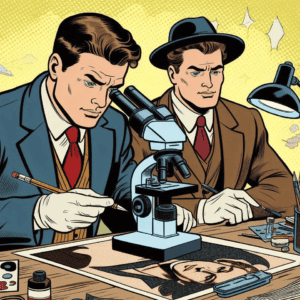 Art conservators use microscopes to carefully examine the pigments and materials used in artworks. By analyzing the composition and layering of pigments, experts can determine the age of a painting, identify any previous restorations, and authenticate the work by comparing it to known standards or the artist’s typical palette.
Art conservators use microscopes to carefully examine the pigments and materials used in artworks. By analyzing the composition and layering of pigments, experts can determine the age of a painting, identify any previous restorations, and authenticate the work by comparing it to known standards or the artist’s typical palette.
Microscopic analysis can also detect signs of deterioration or damage to the pigment layers that are not visible to the naked eye. This information is critical for planning effective restoration strategies that maintain the integrity and value of artworks.
For art enthusiasts and professionals, the ability to uncover the ‘hidden’ layers of paintings and the history they carry enriches the appreciation of art and helps safeguard it for future generations.
Restoration Work
In restoration, microscopes are essential for performing detailed repairs that are sympathetic to the original art. Art restorers use magnification to meticulously clean surfaces, consolidate flaking paint, and apply precise in-painting to areas of loss. These tasks require a careful balance between preserving the original intent of the artwork and ensuring its longevity.
The use of digital microscopy has enhanced this process, allowing restorers to capture detailed images of the art’s condition before, during, and after the restoration. This documentation is invaluable for historical records and provides transparency in the restoration process.
Authentication of Artworks
Authenticating artworks involves a deep understanding of the artist’s methods and materials. Microscopes allow experts to examine the finest details of brush strokes, impasto, and surface textures that are characteristic of specific artists or artistic periods.
This level of detail can confirm the authenticity of a piece, helping to distinguish original works from forgeries. In many cases, ultraviolet and infrared microscopy is used to see underdrawings or signatures hidden beneath the surface paint, further aiding in authentication.
For collectors, dealers, and museums, the ability to authenticate artworks accurately ensures the integrity of the art market and contributes to the scholarly study of art history.
Aspect |
Technique |
Application |
Nugget of Information |
|---|---|---|---|
| Pigment Analysis | Layer Examination | Determining the materials and techniques used | Essential for dating and authenticating artworks. |
| Restoration Work | High-Resolution Imaging | Detailed art conservation | Facilitates precise restoration and documentation. |
| Authentication | Ultraviolet and Infrared Microscopy | Verifying the authenticity of artworks | Crucial for detecting underdrawings and historic repairs. |
Hobbyist and Amateur Use
Microscopes bring the fascinating world of the very small into focus for hobbyists and amateurs, providing a gateway into the wonders of science and nature from a new perspective. This widespread accessibility allows enthusiasts of all ages to engage in scientific exploration and discovery.
Amateur Microbiology
Many hobbyists dive into the realm of microscopy with a focus on microbiology, exploring the microbial life that exists in everyday environments. From pond water to homemade cultures, amateurs can discover the diversity and complexity of organisms that are invisible to the naked eye. This hobby not only satisfies curiosity but also enhances understanding of microbiological processes that impact our world.
These amateur microscopists often share their findings through social media or community science projects, contributing valuable observations to broader scientific pursuits. The engagement in amateur microbiology fosters a community of learners and enthusiasts, encouraging ongoing education and interest in science.
Collecting Microscopic Specimens
Many enthusiasts take pleasure in collecting and preparing their own microscopic slides. This hobby involves collecting samples—from plants, insects, and minerals to more exotic specimens like protozoa from pond water—and preparing them for microscopic examination.
The ability to mount and stain specimens, then examining these under a microscope, gives hobbyists a creative and scientific outlet, allowing them to build their own personal collections of microscopic images. Each slide can reveal a world of intricate details, offering endless opportunities for discovery and documentation.
Educational Outreach and Community Engagement
Amateur microscopy often extends beyond personal interest; many hobbyists engage in educational outreach, sharing their discoveries in schools, clubs, and community centers. By demonstrating how microscopes work and what can be observed, they inspire curiosity and scientific thinking in others, especially young learners.
Interactive sessions where participants can view prepared slides or even learn to use a microscope themselves help demystify science and make it accessible to a wider audience. This form of community engagement plays a vital role in promoting science education and encouraging a new generation of microscopists.
Aspect |
Technique |
Application |
Nugget of Information |
|---|---|---|---|
| Amateur Microbiology | Live Specimen Examination | Exploring microbial diversity | Enables discovery of unseen biological processes. |
| Collecting Microscopic Specimens | Slide Preparation and Staining | Crafting personal specimen collections | Combines scientific exploration with creative expression. |
| Educational Outreach | Community Workshops | Promoting science education | Fosters scientific curiosity and learning in the community. |


